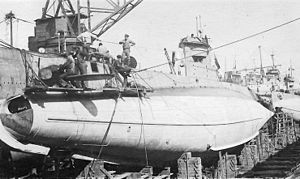- USS O-6 (SS-67)
-
"O-6" redirects here. For the pay grade, see U.S. uniformed services pay grades.

O-6 in drydock at Charleston Navy YardCareer 
Name: USS O-6 Ordered: 3 March 1916 Builder: Fore River Shipbuilding Company, Quincy, Massachusetts Laid down: 6 December 1916 Launched: 25 November 1917 Commissioned: 12 June 1918 Decommissioned: 9 June 1931 Recommissioned: 4 February 1941 Decommissioned: 11 September 1945 Struck: 11 September 1945 Fate: Sold for scrap, 4 September 1946
Scrapped, December 1946General characteristics Type: O class submarine Displacement: 520.6 long tons (529 t) surfaced
629 long tons (639 t) submergedLength: 172 ft 4 in (52.53 m) Beam: 18 ft (5.5 m) Draft: 14 ft 5 in (4.39 m) Propulsion: Diesel-electric
2 × 440 hp (328 kW) diesel engines
2 × 370 hp (276 kW) electric motors
2 shaftsSpeed: 14 knots (26 km/h; 16 mph) surfaced
10.5 knots (19.4 km/h; 12.1 mph) submergedComplement: 2 officers, 27 men Armament: • 4 × 18 in (457 mm) torpedo tubes, 8 torpedoes
• 1 × 3"/50 caliber deck gunUSS O-6 (SS-67) was an O-class submarine of the United States Navy. Her keel was laid down on 6 December 1916 by Fore River Shipbuilding Company in Quincy, Massachusetts. She was launched on 25 November 1917 sponsored by Mrs. Carrol Q. Wright, and commissioned at Boston, Massachusetts, on 12 June 1918 with Lieutenant C. Q. Wright, Jr., in command.
Service history
During the final months of World War I, O-6 operated out of Philadelphia, Pennsylvania, on coastal patrol against U-boats, cruising from Cape Cod to Key West, Florida. A British merchantman fired six shots at O-6 on 14 July 1918, but caused no appreciable damage. On 2 November, the boat departed Newport in a 20-submarine contingent bound for service in European waters, however, the Armistice with Germany had been signed before the vessels reached the Azores, and they returned to the United States.
After the war, O-6 prolonged her Naval career by operating as a training ship out of New London, Connecticut. Reclassified to a second line submarine on 25 July 1924 while stationed at Coco Solo in the Panama Canal Zone, she reverted to first line class on 6 June 1928 and continued at New London until February 1929, when she steamed to Philadelphia, Pennsylvania, to decommission there on 9 June 1931.
Submarines had proved to be a major weapon in World War I. As U.S. involvement in World War II approached, old submarines were taken out of mothballs and prepared to renew training activities. O-6 recommissioned at Philadelphia on 4 February 1941 and then returned to New London to train students at the Submarine School. On 19 June 1941, O-6 made a trial run to Portsmouth, New Hampshire; the next day O-9 (SS-70) went down 15 nautical miles off Portsmouth. O-6 joined O-10 (SS-71), Triton (SS-201), and other vessels in the search for the lost submarine, but to no avail.
Remaining in the Portsmouth area, O-6 decommissioned there on 11 September 1945, was struck from the Naval Vessel Register the same day, and was sold to John J. Duane Company of Quincy on 4 September 1946. The boat was subsequently scrapped in December 1946.
References
- This article includes text from the public domain Dictionary of American Naval Fighting Ships. The entry can be found here.
External links
- Photo gallery of USS O-6 at NavSource Naval History
Designed by Electric Boat Designed by Lake Torpedo Boat List of submarines of the United States Navy · List of submarine classes of the United States Navy Categories:- United States O class submarines
- World War I submarines of the United States
- World War II submarines of the United States
- Ships built in Massachusetts
- 1917 ships
- United States submarine stubs
Wikimedia Foundation. 2010.
